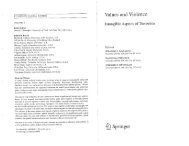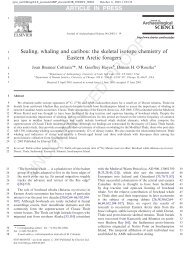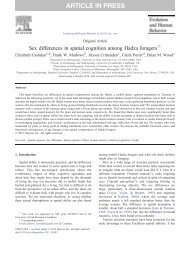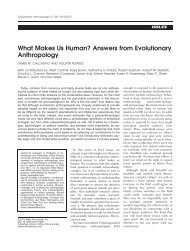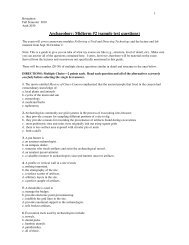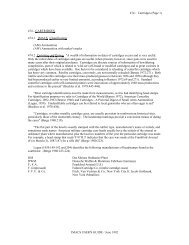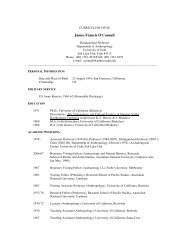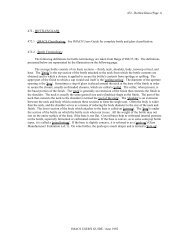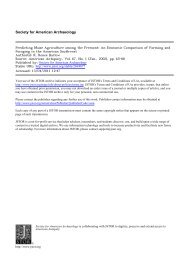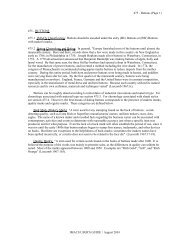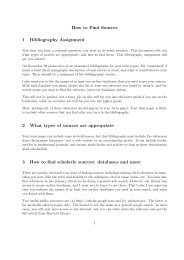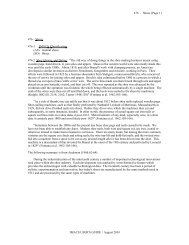Hormones and Competitive Aggression in Women - University of Utah
Hormones and Competitive Aggression in Women - University of Utah
Hormones and Competitive Aggression in Women - University of Utah
Create successful ePaper yourself
Turn your PDF publications into a flip-book with our unique Google optimized e-Paper software.
112 Cashdan<br />
Table IV. Correlations Between Hormone Levels <strong>and</strong> <strong>Competitive</strong> Behaviors<br />
Verbal <strong>Aggression</strong><br />
Noth<strong>in</strong>g Overt<br />
TT .44* .46**<br />
FT .12 .39*<br />
A .40* .49**<br />
TT rank .29 .43*<br />
FT rank .08 .30*<br />
A rank .41* .49**<br />
*po.05, **po.01; n ¼ 30.<br />
TT ¼ total testosterone.<br />
FT ¼ free (unbound) testosterone.<br />
A ¼ <strong>and</strong>rostenedione.<br />
overt.’’ As table IV shows, women with lower levels <strong>of</strong> TT, FT, <strong>and</strong> A were less likely to act<br />
on their competitive feel<strong>in</strong>gs.<br />
In order to m<strong>in</strong>imize the statistical <strong>in</strong>fluence <strong>of</strong> the woman with the highest testosterone<br />
level, hormone values were converted <strong>in</strong>to ranks. As Table IV shows, the correlation between<br />
verbal aggression <strong>and</strong> ranked TT is reduced below statistical significance, although<br />
the relationship with A rema<strong>in</strong>s as strong as before. The relationships <strong>of</strong> TT <strong>and</strong> A with<br />
‘‘noth<strong>in</strong>g overt’’ rema<strong>in</strong> significant, <strong>and</strong> FT shows a trend <strong>in</strong> the same direction. In neither<br />
analysis did estradiol levels show any correlation with aggressive tactics, nor was there any<br />
relationship after remov<strong>in</strong>g from the sample the two women who had higher than expected<br />
E levels.<br />
Although there was no relationship between hormones <strong>and</strong> physical aggression (there were<br />
few physically aggressive <strong>in</strong>teractions), evidence for a possible <strong>in</strong>direct effect is suggested by<br />
differences <strong>in</strong> the object <strong>of</strong> competition. Of the 25 reported <strong>in</strong>cidents <strong>of</strong> physical aggression, 9<br />
<strong>in</strong>volved athletic competition <strong>and</strong> 9 <strong>in</strong>volved gett<strong>in</strong>g one’s way (‘‘try<strong>in</strong>g to get one’s op<strong>in</strong>ion,<br />
plan, course <strong>of</strong> action, etc. to prevail’’). <strong>Women</strong> with low levels <strong>of</strong> estradiol were significantly<br />
less likely to report athletic competitions than were other women (r s ¼ .60, P ¼ .0006,<br />
n ¼ 30).<br />
The relationship actually looks more like a step function: none <strong>of</strong> the 7 women with the<br />
highest E levels had any diaries <strong>in</strong>dicat<strong>in</strong>g competition over athletics, whereas 78% <strong>of</strong> the<br />
rema<strong>in</strong><strong>in</strong>g women, who had E levels lower than 50 pg/ml, reported such competition <strong>in</strong> at<br />
least some <strong>of</strong> their diaries. S<strong>in</strong>ce athletics is a doma<strong>in</strong> where some physical aggression is <strong>of</strong>ten<br />
appropriate, <strong>and</strong> women with high E levels reported fewer such <strong>in</strong>teractions, perhaps the<br />
physically aggressive component may make athletic competition less appeal<strong>in</strong>g to such<br />
women.<br />
While aggression may be a route to success <strong>in</strong> certa<strong>in</strong> competitive arenas, it is probably less<br />
useful when the object <strong>of</strong> competition <strong>in</strong>volves success at school or work, attention from a<br />
prospective mate, or a host <strong>of</strong> other arenas <strong>in</strong> which human adults compete. I used the<br />
cod<strong>in</strong>gs for the object <strong>of</strong> competition <strong>in</strong> order to subset the sample <strong>in</strong>to various categories<br />
(for example, competition over social attention, attention from prospective mates,<br />
competition while engag<strong>in</strong>g <strong>in</strong> athletics, etc.) <strong>in</strong> the hope that I would see a positive<br />
correlation between hormone levels <strong>and</strong> aggression <strong>in</strong> some arenas <strong>and</strong> not others. However,<br />
no clear patterns were detected, perhaps because the number <strong>of</strong> <strong>in</strong>teractions <strong>in</strong> these subsets<br />
was too small.



